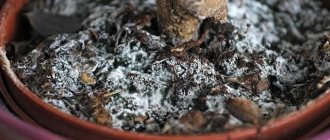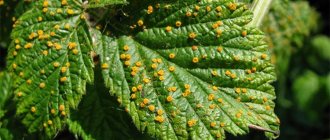Violets are incredibly delicate plants that gardeners are very fond of precisely because they are very attractive, and at the same time you don’t have to make enormous efforts to care for indoor violets - they are completely unpretentious. These flowers are beautiful, moderately capricious, and the gardener should still spend some time and energy caring for the flowers, as they deserve it. In response, violets produce excellent decorative flowering, look very fresh and interesting, their immunity and stress resistance are at a high level. But if a grower violates agricultural practices, rules and regulations for watering and maintaining Saintpaulia, this leads to the plant being exposed to infectious and fungal diseases, which are indeed very dangerous for the plant. The diseases have several symptoms, including the appearance of uncharacteristic spots on the leaf blades, wilting and subsequent shedding of the petals. If suddenly the grower at some point noticed that a white coating had formed inside the rosette, then this would indicate that the violets were sick with powdery mildew, and it is imperative to organize treatment for the plant, otherwise it will simply die. Today there are many modern measures that, together, can destroy fungal spores. Only thanks to this will it be possible to save the flower, since powdery mildew on violets is a serious disease.
What Causes Powdery Mildew on Violets?
photo: powdery mildew on violets
Powdery mildew is considered a disease caused by microscopic fungi and spores that live in the soil. Mycelia, which form as plaque, primarily appear on leaves and petioles, as well as on the inflorescences and petals themselves. Fungal spores themselves appear as dark brown or light brown balls that are carried by the wind, and can also move along with water droplets when the grower waters the plants. The disease can be recognized by the fact that a gray-whitish atypical coating begins to appear on different parts of the plant. First, it covers the petioles, leaf plates that are located near the surface of the soil. Then these same spots begin to spread very quickly throughout the entire plant, which indicates that powdery mildew has reached its progressive form of the disease. If the grower blows lightly on the leaves, he will notice that dust will rise above them, and it may seem that it is just dirt that has accumulated on the leaves. But this is not at all true, and if you simply wipe the spots on the leaves, then powdery mildew will not go away at all from such a measure. Much more serious measures are needed in order to save the landing.
When the disease is just beginning, the plaque is not so noticeable to the naked eye of the grower. Therefore, the plant must be regularly inspected for disease or lesions or damage. When myceliums with spores begin to take root, they are fed by the plants themselves, the leaves, and therefore the leaf plates are quickly covered with plaque. In this case, the leaves cease to cope with the process of photosynthesis, the plant begins to weaken very much, loses its vitality, and becomes inconspicuous and completely ugly. Small ulcers appear on the leaves, which then spread to the flower petals. The affected parts of the plant should be removed immediately, and this is worth doing for several reasons:
- they are quite difficult to process, and treatment against powdery mildew may not give any result at all, and the disease will spread to healthy plantings
- peduncles can take away the strength of the plants, and then he will have absolutely no energy left to fight the developed disease.
Classification of diseases
Of course, indoor violet diseases are easier to prevent than to treat. If there is a suspicion that the plant is sick. First, you need to determine what happened. There can be many reasons:
- If the disease is caused by a fungal, bacterial or viral infection, they must be isolated from other indoor plants before treatment. Many of these diseases are highly contagious.
- The same goes for parasite infestation. In this case, in addition to quarantine, it is worth applying complex treatment even to those plants that seem healthy.
- It’s easier if the disease is not infectious. In this case, simple agricultural techniques are sufficient. As a rule, such diseases are associated with a deficiency of certain substances.
Let's look at some diseases of violets and their treatment.
Powdery mildew on violets - types of fungal diseases
Powdery mildew on violets: photo
Fungal infections can be of different types, and this classification is also necessary to know in order to take timely and appropriate measures in pest control. Firstly, powdery mildew is a whitish coating that covers multiple green parts of the violet, and can also spread to still healthy flower stalks, affecting them. Secondly, downy mildew - this disease can be distinguished from true powdery mildew by the nature of the lesion. White plaque mainly affects the lower part of the leaves, but brown, red spots appear on top. The disease can progress and intensify if there is a draft, sharp gusts of wind and high air humidity in the room where the violet is located, which is contrary to the rules of agricultural technology. Downy mildew has an extremely negative effect on the immunity and stress resistance of plantings. In order to get rid of the fungal mycelium, which provokes the development of the disease, it is necessary to use professional medications. The most sought after and popular among them are topaz and sapropol, quadris and ordan. These drugs must be used exclusively in accordance with the instructions for use, otherwise you can cause damage not only to violets, but also to your own health.
Also, of course, in order to understand why powdery mildew on violets is dangerous, it is best to become more familiar with the consequences it can lead to. Fungi develop superficially, and the main damage they cause is precisely the decorativeness and attractiveness of the plant, its external characteristics. If you do not provide the plant with proper treatment and care, if you do not take timely measures, then the fungus will only grow. There are several effects that powdery mildew causes.
Firstly, over time, leaves that have been infected begin to gradually darken. They become deformed, curl, dry out and fall off the bush. They can also develop spots and uneven spots, ulcers, which indicate that something terrible is happening to the shrub, and that it needs immediate measures to be taken by the grower. Secondly, shoots and buds stop developing. Plant growth slows down, there is no flowering, which means the flower loses one of its most important functions - decorative. Thirdly, the plant stops growing, although in general we also outlined this point in the previous paragraph. But in general, the violet looks very tiny, inconspicuous, sick, and gets lost against the background of other plantings. The bottom row at the rosette generally dies off, so there can be no talk of any full-fledged further development of the plant at all.
Powdery mildew on violets: photo
Of course, powdery mildew on violets has its own causes. Spores can easily be in the air or in the soil; for the time being they sleep. The impetus for their awakening and subsequent development is that the violet’s immunity becomes very weak, it ceases to fight attacks from the outside. In not the most favorable conditions, when the grower did not overlook something or did not follow agricultural practices, the flowers lose their resistance to infections and, as a result, become infected with powdery mildew spores. But the question immediately arises of how the spores themselves can get onto the plant. Here we propose to consider several options for infecting violets with powdery mildew:
- they end up on the flower along with the new soil mixture
- spores are carried by sharp gusts of wind, as well as on clothes that the grower puts on himself
- the fungus can enter the room or room where the violet is kept, along with cut flowers. It can also get in with new indoor plants. It is for this reason that gardeners recommend quarantining new flowers for a while, and only then displaying them along with the usual plantings.
Spores can be easily transmitted from diseased flowers to healthy ones; they can be spread through clothing, hands, and tools that the grower uses to process the plants. It is also possible to transmit spores even through splashing water. This disease occurs most often in the spring and autumn. This especially happens when the air temperature in the room drops, which, of course, causes disputes to intensify. In Saintpaulia, immunity begins to decrease too quickly, stress resistance disappears, due to which, in principle, the plant feels normal. It is also, of course, worth saying that a decrease in immunity can be triggered by several factors.
Firstly, the grower may violate the rules of agricultural technology. This becomes the main and most common reason why powdery mildew forms on violets. This can also be caused by excessive watering due to the fact that the container for the plant was selected too large. Secondly, an excess of nitrogen and a lack of phosphorus is exactly what can lead to the formation of fungal formations and spores of powdery mildew on the plant. Thirdly, if you keep a flower at a temperature below 18 degrees, and if the air humidity is below 70-80%, then this will also affect the condition of the plant and the fact that it will begin to get sick, immunity and stress resistance will noticeably decrease. Fourthly, insufficient lighting, provided that the plant is very heat-loving and tolerates prolonged lighting. If the violet receives very little light, then it becomes weaker and, accordingly, vulnerability to diseases, viruses, and even more so to fungal infections appears. In general, the factor of keeping flowers in unsuitable conditions, the inability to create an optimal microclimate for plantings, is also a significant point, which precisely affects the fact that the plant will get sick. Inappropriate conditions in this case are the lack of wet cleaning, accumulation of dust on the leaves, close placement of pots, thickening of the crown of violets.
Causes
The reasons why white plaque forms can be divided into two groups.
- Disadvantages in violet care.
- Fungal, viral and bacterial diseases. In this case, a fungal disease will be considered, since it is most typical for Saintpaulia.
There can be several problems in daily care.
Poor quality soil
If the soil is excessively heavy, it does not pass and absorb liquid well enough. What is not absorbed evaporates from the soil surface over time, leaving salt in the top layer. Stagnation can also be caused by a non-functioning drainage system, so excess water cannot escape and collect in the pan.
Solution: completely change the soil; it is better to purchase it specifically for violets at a flower shop.
You can put small pebbles at the bottom of the pot to improve drainage, and the container itself must have holes at the bottom.
Unsuitable water
Ordinary tap water is rich in heavy metals, various compounds and salts. These substances gradually accumulate on the surface and form a white coating.
Solution: it is better to choose filtered water for irrigation or let tap water settle. If possible, you can use rain or melt water.
However, it must be warmed to room temperature.
Excess funds for feeding
Fertilizers are an indispensable tool for additional saturation of the soil with valuable microelements. Feeding is especially important during the period of plant growth and flowering. However, in the autumn-winter period, when all vital processes of violets slow down, conventional additives can cause oversaturation of the soil.
Solution: you just need to clean off the top layer of the substrate and add a new one.
Air humidity and temperature
An environment that is too dry leads to accelerated evaporation of water and the formation of plaque. Excessive watering and waterlogging lead to the same result.
Powdery mildew on violets: flower treatment and how to deal with the disease
photo: powdery mildew on violets
Having considered the specifics of the disease, it is very important to understand what methods there are to treat violets for powdery mildew. Today, a large number of special drugs have been created that are specifically designed to fight fungal diseases and infections - this is a fungicidal group of drugs. In addition to the fact that plants are treated with agents and preparations, they also need to be kept in the most favorable conditions. This means that something needs to be changed if, under current conditions, the plant manages to get sick.
For example, you can slightly adjust and lower the air humidity. To do this, it is recommended to refrain from watering until the top layer of soil has completely dried out. It is also recommended to place the flowers in a warm place that will be well lit so that the planting feels as comfortable as possible. Thirdly, experienced gardeners recommend removing the top layer of soil, since it is in it that fungal spores can live. After this, a fresh substrate is laid, to which the plant quickly adapts. Fresh substrate is pre-disinfected by calcination. After the plants have been treated with special preparations, it is recommended to wait a while and not immediately expose the plants to light. They should dry out a little. And only after this the gardener returns the plantings to their usual habitat and places them in their usual place.
It is worth removing all affected parts of the plant from the outlet, usually leaves and flower stalks. The place where the bush was located, the surface of the container and the tray must be thoroughly washed and disinfected using a preparation such as Topaz. At the initial stage, leaves that have been infected can be treated with sulfur agents. You can also spray the flowers with lukewarm water, then powder them with sulfur powder, and put a bag on top for a while. You should remember safety precautions, since the substance is toxic, so during processing it is recommended to protect the mucous membranes and not inhale this powder.
Release form
For owners of private household plots and summer residents, the Topaz fungicide is sold in small ampoules with a capacity of 2 ml . The ampoules, in turn, are packaged in a moisture-proof bag.
For agricultural enterprises whose volumes of treating crops against fungal infections are many times greater than those of private traders, the product is produced in plastic canisters with a volume of 1 liter.
The manufacturer guarantees the effectiveness of the drug for 4 years , but provided that the packaging is intact.
Important! After the expiration date, it is strictly forbidden to continue using the drug for its intended purpose. Over the years, the toxicity of the product increases sharply; it will cause serious harm to violets.
How to treat violets against powdery mildew
How to treat violets against powdery mildew: photo
Fungicides are one of the most effective and fastest ways to treat violets from powdery mildew. Before the procedure, the violet should be cleaned, all dirt and dust that may have accumulated on the flower should be removed; to do this, just rinse the plant under running water. Spraying with the preparations should be intense and very abundant, until the liquid, which is this very remedy, begins to drain from the leaves. I would like to describe several fungicidal preparations, which are considered today one of the most effective, affordable and indeed very significant in the fight against such a scourge as powdery mildew.
The drug Bayleton is a systemic fungicide that quickly fights powdery mildew, as well as diseases such as rot and scab. The active ingredient of the drug is triadimefon, it is used for effective express control of fungal formations on vegetable and fruit bushes and trees, as well as for the control of fungi on flowers. This product is available in two forms: concentrated emulsion and water-soluble powder. Which form to choose is up to the grower to decide; they have exactly the same sphere of influence. It is recommended to apply the drug in the form of a solution, which is sprayed from a spray bottle. It is necessary to treat both infected and healthy parts of the plant. The procedure will stop the spread of the fungus and localize it to only one part of the plant. The leaves should be processed very carefully, on both sides. The remaining solution can simply be poured into a lump of earth in which the violet root system is located. Also, in addition to the fact that the drug fights bacteria and fungi, it also helps to saturate the soil with zinc, as it is very important for recreating the decorative appearance of the plant. In case of severe infection, it is worth treating the violet again, after about 7-10 days, no later.
Powdery mildew on violets: photo of the disease
Topaz is a fungicide that contains an active substance called penconazole. Treatment of violets with topaz against powdery mildew is carried out not only for the treatment of fungal diseases, but also for prevention. Only a liquid concentrate of this drug can be found on sale, and in particular the drug will be effective in the very early stages of powdery mildew infection. A solution is prepared from the liquid, following the instructions for using the drug. The leaves are wetted on both sides. If the flower is very severely affected, then increasing the concentration of the drug is allowed. The number of applications will depend on the condition of the plant, and more than one application may be required. It is worth maintaining a break of 10-14 days between sprayings. The drug Topaz has its great advantages over many other drugs - it is odorless and does not leave marks or streaks on the leaves. It is also worth noting that the drug has a protective effect that lasts for two weeks. Treating violets with topaz against powdery mildew is absolutely safe for both humans and animals, but it is still worth remembering safety precautions when using such a product, because it is, first of all, a chemical.
The drug Fundazol - the product has an effect on a huge number of pests and effectively fights pathogenic bacteria and fungi. It is most often used to treat violets and other indoor plantings, and the product is excellent for combating powdery mildew. Fundazol is available in powder form, which is dissolved in small quantities in warm water. The preparation can be used to treat any part of the violet; its effectiveness is also evident if the preparation is applied directly to the soil so that it is absorbed by the root system. But you shouldn’t forget about safety measures - you need to work with the drug with gloves, glasses, and a mask, since it is very toxic. After treatment, animals should not be allowed near the plant - they can also get toxic poisoning.
Powdery mildew on violets: photo of the disease
Pale and light leaves
Most varieties of violets grow with beautiful decorative leaves, so it is quite easy to notice when they fade and fade. Find out the reason and quickly adjust the care - then the flower will recover on its own!
- Sucking insects draw out all the juices from the violet, and it fades and withers;
— Nematodes eat the root system, which is why the above-ground part grows weak, sluggish, pale and deformed.
Photo: domashniecvety.ru
Diseases of strawberry leaves: descriptions with photos, treatment
Powdery mildew on violets: treatment with folk remedies
There are also folk recipes for combating powdery mildew. One of these simple and yet effective methods is the use of iodine. Iodine for powdery mildew on violets can be added to water and sprayed on areas that have been affected by the disease. To measure the required amount of iodine, you should use the most common medical syringe. As a rule, about three milliliters of iodine are added to one liter of water to prevent powdery mildew on violets.
You can also use whey - it is effective and completely safe for humans. The serum is mixed with water, and then the flower is treated with the liquid not in one, but in three approaches at once. The interval between treatments is no more than three days. Experienced flower growers also recommend using soda ash, which is excellent at fighting fungus. It can be mixed with liquid soap and water, and the resulting solution can be used to treat leaves and other parts of the violet that have been affected by powdery mildew. After about one week, treatment with this liquid can be repeated. But it is still worth remembering that all these remedies will be especially effective in the very first stages of the development of the disease, since then the fungi will only be vulnerable to chemicals.
Prevention of disease occurrence
Powdery mildew on violets: photo
Let's talk a little about the prevention of powdery mildew on violets. It consists of several mandatory activities that can be performed in different orders:
- indoor plants are treated twice a year - in spring and autumn, using a drug called Topaz for treatment
- It is worth following all the recommendations and nuances that relate to watering and temperature conditions, and in general creating a favorable microclimate for the plant
- new flowers must be quarantined for some time, and only after that can they be sent to all other plantings
- plants that show even the smallest signs and symptoms of the disease should be immediately isolated from healthy plants. This will prevent the fungus from further spreading to other Saintpaulias.
- soil, containers and tools must be disinfected
- Violets must receive enough light. If necessary, the gardener can use additional lamps and phytolamps
- Cut flowers should not be left near indoor plantings, as they can become a source of infection. If you follow all these rules, you can not only save your plantings, but also increase them. The most important thing is to be vigilant, understand your responsibility for your own indoor plants and take into account the nuances and agrotechnical subtleties. In this case, even a gardener without experience will be able to cope with the plants.
Powdery mildew on violets: how to get rid of the disease?
Leaves turn yellow and dry out
It is a pity if large violet leaves begin to dry out, especially when they should not do so. But this is exactly the problem that flower growers face most often!
— Violet leaves turn yellow and wither if the conditions are not suitable for it, because each variety has its own characteristics;
— Leaves may turn yellow if they are constantly exposed to water when watering;
— Ring yellow spots appear in winter when the flowerpot is in a draft;
— The plant turns yellow, becomes stunted and lethargic due to root rot. Then urgent drying and replanting with fungicide treatment is needed;
— Wide yellow trails on the leaves are left by thrips when they eat away the pulp.
Photo: raiclimat.ru











